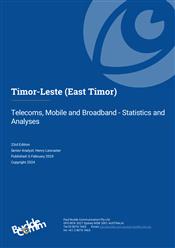Timor Leste (East Timor) Telecoms Market Report
Telecoms, Mobile and Broadband - Statistics and Analyses

Last updated: 6 Feb 2024 Update History
Report Status: Current
Report Pages: 84
Analyst: Henry Lancaster
Timorese making progress with its first international submarine cable link
Timor-Leste has been moving forward with the regeneration of its economy and rebuilding key infrastructure, including telecommunications networks, which had been destroyed during the years of civil unrest. On the strength of this, the government was well placed to launch the Timor Digital 2032 program, aimed at developing digital services and the ICT sector, and delivering a range of digital services covering areas such as government, health, and education.
Fixed-line and fixed broadband penetration in Timor-Leste remains extremely low, mainly due to the limited fixed-line infrastructure. However, Timor Telecom’s national terrestrial fibre network has helped boost fixed broadband subscriber growth and will continue to do so over the next few years. Despite this, the sector requires greater organisation and discipline: in urban areas, operators frequently lay telecom cables in a haphazard and chaotic fashion, which has led the national electricity provider to call on the telecom regulator to bring some order in the use of existing poles.
Timor-Leste has three telcos - Timor Telecom, Telkomcel and Telemor - which jointly provide 98% national coverage with their mobile infrastructure. All three launched LTE services during 2019, and this has resulted in a rapid increase in mobile broadband penetration, driven by a rising proportion of mobile subscribers having smartphones. While the mobile broadband market is still at an early stage of development, strong growth is predicted over the next five years.
The capability of telecom services will be enhanced when the country is connected to the submarine cable linking to Australia via the North Western Cable System (NWCS). While a prefabricated modular landing station is due to be delivered to Dili in April 2024, bureaucracy, and a degree of indecisiveness on the part of the government risks that connectivity to the NWCS will be delayed.
Key developments:
- Government sets up Timor Digital 2032 as a major strategic plan aimed at developing digital services and the ICT sector, focussed on economic development, and delivering a range of digital services.
- Telemor extends mobile satellite agreement with SES.
- Bureaucracy and indecisiveness risks delaying Timor Leste’s first submarine cable connection.
- Telemor aiming to launch a 5G service once the Timor-Leste South Submarine Cable is in service, and providing the necessary bandwidth to keep up with anticipated data demand.
- Report update includes ITU data updates, the regulator’s market data updates; telcos' financial and operating data, recent market developments.
Companies covered in this report include:
Timor Telecom, Telkomcel, Telemor, Kacific Broadband Satellites, Viettel, Portugal Telecom, Ceslink, Vocus, PT Telekomunikasi Indonesia International (Telin)
Related Reports
- Asia - Mobile Infrastructure and Mobile Broadband
- Asia - Fixed Broadband Market - Statistics and Analyses
- Asia - Mobile Network Operators and MVNOs
- Sri Lanka - Telecoms, Mobile and Broadband - Statistics and Analyses
- Kazakhstan - Telecoms, Mobile and Broadband - Statistics and Analyses
- Japan - Telecoms, Mobile and Broadband - Statistics and Analyses
- Hong Kong - Telecoms, Mobile and Broadband - Statistics and Analyses
- Philippines - Telecoms, Mobile and Broadband - Statistics and Analyses
- Mongolia - Telecoms, Mobile and Broadband - Statistics and Analyses
- Malaysia - Telecoms, Mobile and Broadband - Statistics and Analyses
Share this Report
TMT Intelligence
A platform to scale your intelligence tasks
Monitor critical insights with our AI-powered Market Intelligence Platform gathering and analyzing intelligence in real time. With AI trained to spot emerging trends and detect new strategic opportunities, our clients use TMT Intelligence to accelerate their growth.
If you want to know more about it, please see:
Research Methodology
BuddeComm's strategic business reports contain a combination of both primary and secondary research statistics, analyses written by our senior analysts supported by a network of experts, industry contacts and researchers from around the world as well as our own scenario forecasts.
For more details, please see:
More than 4,000 customers from 140 countries utilise BuddeComm Research
Are you interested in BuddeComm's Custom Research Service?
Hot Topics
News & Views
Have the latest telecommunications industry news delivered to your inbox by subscribing to BuddeComm's weekly newsletter.